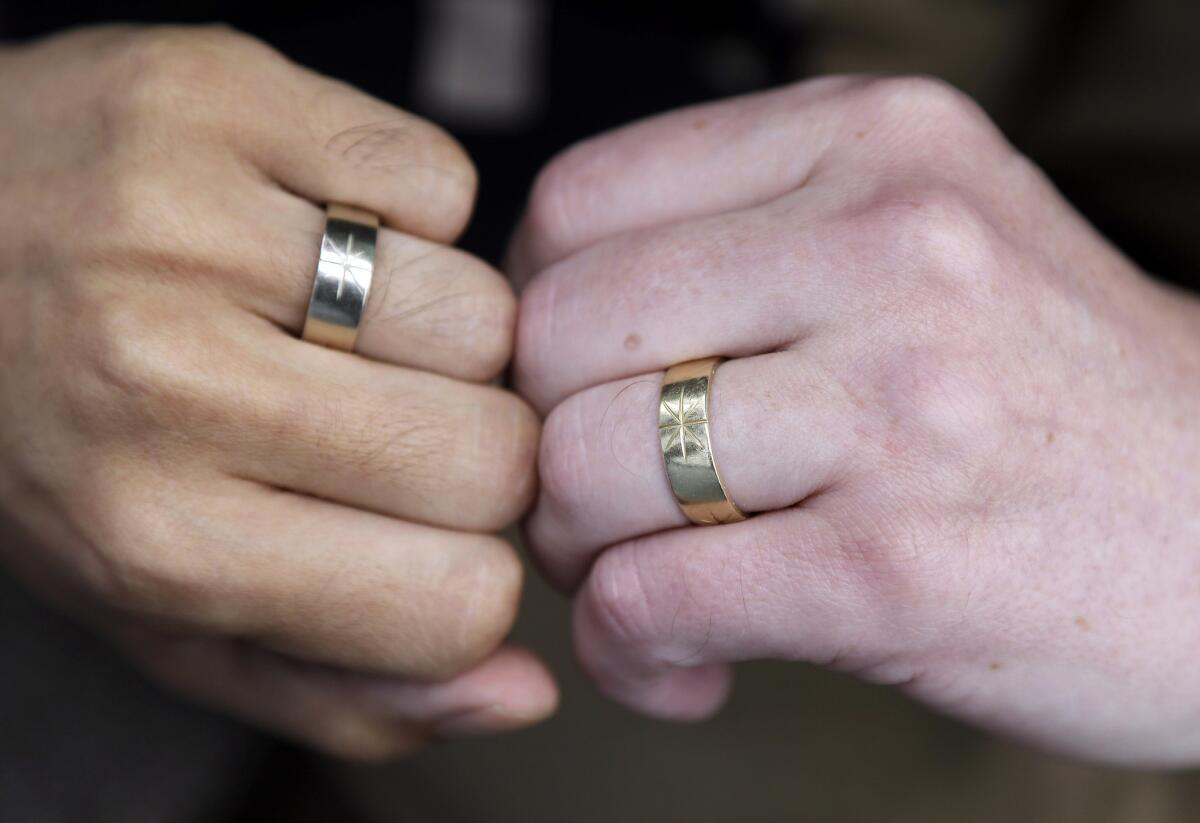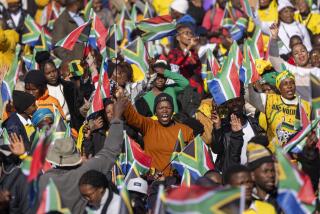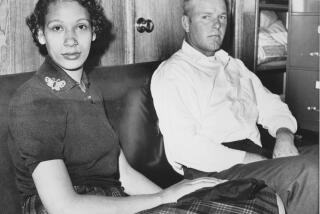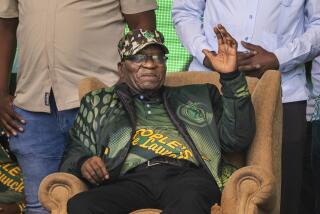South Africa’s path to marriage equality

- Share via
I can’t say, of course, how the U.S. Supreme Court will rule on the same-sex marriage cases before it. But I can talk about how South African courts grappled with the issue in 2005, after a case was brought by a lesbian couple who had been denied the right to marry. As a justice on the Constitutional Court at the time, I was asked to write the judgment in that case, which led to South Africa’s becoming the fifth country in the world to legalize same-sex marriage.
The case before the court involved Marié Fourie and Cecelia Bonthuys, two Pretoria women who had lived as a couple for 10 years and wanted to get married. The local state marriage officer said that although he would be willing to officiate, the law prevented him from doing so. South Africa’s Marriage Act required the recitation of a vow that included the specific terms “husband” and “wife,” and because Fourie and Bonthuys were both women, he could not perform the ceremony.
They went to court to challenge the decision, and at around the same time, a gay rights advocacy group brought a lawsuit challenging the constitutionality of the marriage vow. The court consolidated the two cases so they could be heard together.
TIMELINE: Gay marriage chronology
The issue was sharply contested. South Africa’s post-apartheid Constitution banned discrimination based on sexual orientation, but marriage between two people of the same sex wasn’t specifically addressed. And the common law at the time defined marriage as “a union of one man with one woman, to the exclusion, while it lasts, of all others.”
By the time we took up the matter, it was clear that the “M-word” aroused fierce passions on both sides of the debate. On the day the case was heard by the Constitutional Court, South Africa’s equivalent of the U.S. Supreme Court, the gallery was packed with people on both sides as well as journalists from all over the world.
Counsel representing religious groups acknowledged that same-sex couples had a constitutional right to legal protection for their unions. But marriage, they argued, was an intrinsically heterosexual institution created by religious bodies to legitimize procreation. Accordingly, there was nothing unfair in denying same-sex couples access to it, provided the law protected same-sex relationships adequately in other ways.
FULL COVERAGE: Prop. 8 and DOMA
Counsel on the other side argued that common law and the Marriage Act were unfairly discriminatory and therefore unconstitutional.
This was one of those cases where the manner of explaining a decision and the adoption of an appropriate remedy turned out to be as important as the actual technical reasoning employed. A crucial dimension was the role that the legislature should play in providing an appropriate remedy. We debated the issues in at least five workshops before coming to agreement on the final text. Finally, in all but one respect, we were able to achieve unanimity.
At the heart of the ruling was the court’s basic belief that respect for the dignity of all human beings lay at the heart of our quest for equality. As the judgment put it: “Indeed, rights by their nature will atrophy if they are frozen. As the conditions of humanity alter and as ideas of justice and equity evolve, so do concepts of rights take on new texture and meaning…. What was regarded by the law as just yesterday is condemned as unjust today.”
VIDEO OP-ED: Fighting for gay marriage and immigration reform
The justices agreed that denying same-sex couples the status, rights and responsibilities that the marriage law granted to heterosexual couples represented a profound violation of their dignity and right to equality. The court noted that the unfair discrimination came not from gay men and lesbian women being expressly targeted for exclusion but from their being made invisible, as if their love, intimacy and acceptance of mutual responsibility were not worthy of the same kind of public legal recognition available to male-female couples. We concluded that the situation could not be remedied by applying the notorious doctrine of “separate but equal,” with its connotations of unworthiness.
Finally, the judgment dealt extensively with the relationship between the sacred and the secular. It acknowledged the meaning that religion has for millions of people in our society, and emphasized that it was inappropriate to regard opponents of same-sex marriages as bigots. Rather, South Africa’s Constitution called for coexistence between the sacred and the secular. The same text that barred using religious beliefs as a means of denying the fundamental rights of others protected members of faith communities from being compelled to celebrate relationships that went against their deeply held beliefs.
The one point of dissent among the justices concerned how the remedy for this unconstitutionality should be crafted. One justice held that the court should simply mandate the use of gender-neutral words in the marriage vow, which would mean same-sex couples could begin marrying immediately. The remaining 10 justices, however, felt that it was the role of the legislature to enact statutory changes that would permit same-sex marriages. Ultimately, we gave Parliament one year to adopt the necessary legislation, with the caveat that if it failed to do so, the words “or spouse” would be automatically be read into the law.
Just days before the allotted year had elapsed, Parliament adopted a new law in response to the court order that made it legal for same-sex couples to marry.
Two weeks later, I entered the parking area of Kirstenbosch Botanical Gardens in Cape Town, looking for promised directions, and found a sign with an arrow: “To Amy and Jean’s marriage.” It seemed so simple, so obviously right that a couple who loved each other could marry in this most family oriented of places. Today, such unions are commonplace in South Africa. Indeed, many South Africans are proud that our country helped lead the way in allowing people the fundamental right to be who they are.
Albie Sachs was appointed by Nelson Mandela to be a justice on the Constitutional Court of South Africa in 1994. He retired in 2009.
More to Read
A cure for the common opinion
Get thought-provoking perspectives with our weekly newsletter.
You may occasionally receive promotional content from the Los Angeles Times.






